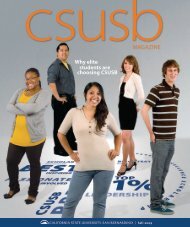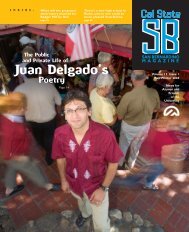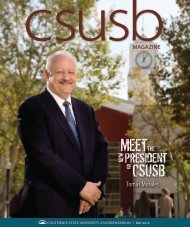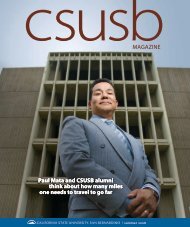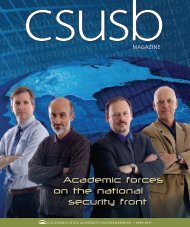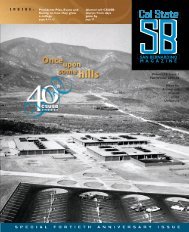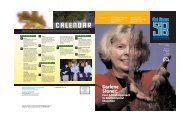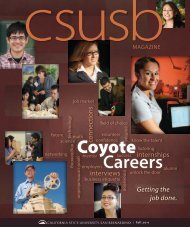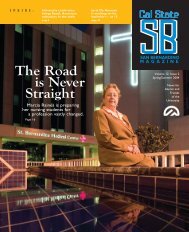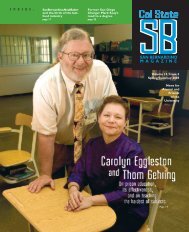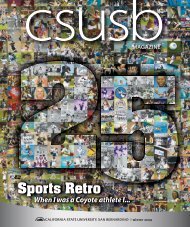Insights into the Ancient, the Contemporary Insights into the Ancient ...
Insights into the Ancient, the Contemporary Insights into the Ancient ...
Insights into the Ancient, the Contemporary Insights into the Ancient ...
You also want an ePaper? Increase the reach of your titles
YUMPU automatically turns print PDFs into web optimized ePapers that Google loves.
NAtUrAl SCIENCES<br />
Do i n g T h e maT h … a n D SC i e n C e<br />
From ice core drillings in Antarctica to<br />
core programs at Cal State San Bernardino,<br />
<strong>the</strong> National Science Foundation funds<br />
research and education projects that, according<br />
to its Web site, “have been judged <strong>the</strong> most<br />
promising by a rigorous and objective meritreview<br />
system.” With that, <strong>the</strong> NSF has<br />
awarded a $500,000 grant to CSUSB’s<br />
Bo n e S o f STeel<br />
What seemed so remarkable<br />
was that <strong>the</strong> building had arrived at<br />
that mid-way point in construction<br />
so rapidly. Work began in earnest<br />
last June. When hard hats raised<br />
<strong>the</strong> final girder at <strong>the</strong> College of<br />
Education topping out ceremony<br />
in <strong>the</strong> spring you could easily see<br />
<strong>the</strong> structure’s shape, <strong>the</strong> various<br />
juts and vertical reaches, building<br />
curves branching off long straight<br />
sections, <strong>the</strong> tiered roof lines.<br />
Patricia Arlin, dean for <strong>the</strong> education<br />
college, put her signature – as<br />
did many o<strong>the</strong>rs – to <strong>the</strong> final beam<br />
on a day so clear you could almost<br />
see all <strong>the</strong> way to <strong>the</strong> end of <strong>the</strong><br />
building’s completion one year<br />
from now.<br />
College of Natural Sciences to help fund its<br />
Ma<strong>the</strong>matics and Science Scholars program<br />
for <strong>the</strong> next four years.<br />
The MASS program is serving students<br />
from a variety of backgrounds with financial<br />
need who will study in <strong>the</strong> science, technology,<br />
engineering and ma<strong>the</strong>matics’ disciplines. At<br />
Cal State San Bernardino, <strong>the</strong> federal funding<br />
focuses on <strong>the</strong> fields of biology, chemistry<br />
and biochemistry, <strong>the</strong> computer<br />
sciences, geological sciences, ma<strong>the</strong>matics<br />
and physics.<br />
Program candidates are recruited<br />
from <strong>the</strong> top 2 percent of high school<br />
graduates throughout San Bernardino<br />
and Riverside counties. Beginning<br />
in fall 2007, MASS scholarships will<br />
be awarded to at least 14 incoming<br />
freshmen. The program will also<br />
award scholarships to eight current<br />
CSUSB juniors and eight seniors,<br />
who will serve as role models for <strong>the</strong><br />
freshmen. Scholarship recipients must<br />
be full-time students and maintain a<br />
minimum 3.3 grade point average to<br />
receive <strong>the</strong> $3,500 a year. The scholarship<br />
is for a maximum of four years.<br />
Both public and private sources<br />
will help extend <strong>the</strong> MASS program<br />
beyond <strong>the</strong> four years. The<br />
university’s College of Natural<br />
Sciences is also being funded through<br />
several local companies and agencies,<br />
which have already pledged<br />
support for <strong>the</strong> MASS program,<br />
including QMotions, Associated<br />
Engineers Inc., Mojave Desert Air<br />
Quality District, Kelly Space and<br />
Technology Inc. and Optivus.<br />
aiDS, my T h S<br />
a n D ne Pa l<br />
High school, college-age and young professionals<br />
in Nepal are no different than <strong>the</strong>ir<br />
American counterparts when it comes to knowing<br />
about HIV and AIDS.<br />
“Most young people have an extensive<br />
surface knowledge about <strong>the</strong> disease,” said Cal<br />
State San Bernardino professor Marsha Greer,<br />
who spent five months in Nepal last year as a<br />
Fulbright Scholar. “But when you get below<br />
<strong>the</strong> surface, <strong>the</strong>y have many misconceptions<br />
and a surprising lack of real knowledge.”<br />
Greer, an assistant professor of health science<br />
and human ecology and coordinator<br />
of <strong>the</strong> master’s program in public health at<br />
Kathmandu Valley, Nepal<br />
CSUSB, studied knowledge of and attitudes<br />
toward HIV and AIDS among young people in<br />
<strong>the</strong> Himalayan nation.<br />
Greer said <strong>the</strong> government of Nepal estimates<br />
that <strong>the</strong>re are about 60,000 cases of<br />
HIV or AIDS. The United Nations puts <strong>the</strong><br />
figure as high as 110,000. Nepal has a population<br />
of some 28 million.<br />
Greer worked at Kathmandu College<br />
of Management, which is affiliated with<br />
Kathmandu University.<br />
“There are 76 different ethnic groups” and<br />
several different religious traditions in Nepal,<br />
she said. This makes for a lively tapestry of<br />
multiculturalism, she added, that both enriches<br />
life but could make it dangerous.<br />
9<br />
Spring/Summer CSUSB



